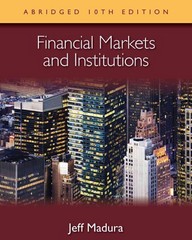Question
Chapter 6 1. Modern portfolio theory was originally advanced by: a. Harry Markowitz and the identification of standard deviation as a measure of risk. b.
Chapter 6
1. Modern portfolio theory was originally advanced by:
a. Harry Markowitz and the identification of standard deviation as a measure of risk.
b. William Sharpe and the capital asset pricing model.
c. Eugene Fama and the efficient markets hypothesis.
d. Stephen Ross and the arbitrage pricing theory.
2. The behavioral finance aspect that most likely offers a unique and reasonable explanation for the persistence of the equity premium puzzle is:
a. Emotional bias. b. Bounded rationality. c. Myopic loss aversion. d. Heuristic security valuation.
3. A large firm announces it has hired a design company to change its corporate logo. The new logo will be shown publicly for the first time the following day. Shareholders react by bidding up the shares by 10% over the relevant benchmark. No other information about this firm is released. The shareholder reaction can best be described as:
a. Anchoring. b. Representativeness. c. Cognitive dissonance. d. Mental accounting.
4. Harold Smith sits on four boards of directors of publicly held companies, each operating in a different industry. Smith has an ethical clause in each of his board contracts but ignores them by trading on information he learns during board meetings. Smith generates an average return on these trades that is well above any relevant benchmark. The market under these conditions is most likely:
a. Inefficient. b. Weak form efficient. c. Semi-strong form efficient. d. Strong form efficient.
5. Perhaps the biggest behavior mistake made by both individual investors and money managers during the dot com bubble was:
a. Loss aversion. b. Mental accounting. c. Assuming market efficiency. d. Herd mentality.
Chapter 7
1. Money market securities are:
a. Readily marketable. b. Low volatility. c. Highly liquid. d. All of the above.
2. Commercial paper is most likely issued by:
a. The Federal Reserve bank. b. Commercial banks. c. Large, well-known companies. d. A securities exchange.
3. A Treasury bond has an ask price of 107.04 and a bid price of 107.00. What is the dollar price a buyer expects to pay?
a. $1,070.00. b. $1,070.40. c. $1,071.13. d. $1,071.25.
4. The primary difference between Treasury notes and bonds is:
a. Maturity. b. Default risk. c. Coupon rate. d. Taxability
5. The price of a bond that a buyer would pay is equal to:
a. The asked price plus accrued interest. b. The asked price less accrued interest. c. The bid price plus accrued interest. d. The bid price less accrued interest.
Step by Step Solution
There are 3 Steps involved in it
Step: 1

Get Instant Access to Expert-Tailored Solutions
See step-by-step solutions with expert insights and AI powered tools for academic success
Step: 2

Step: 3

Ace Your Homework with AI
Get the answers you need in no time with our AI-driven, step-by-step assistance
Get Started


